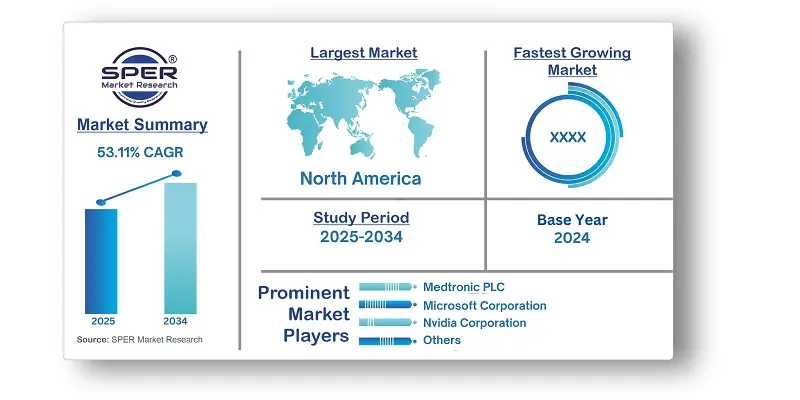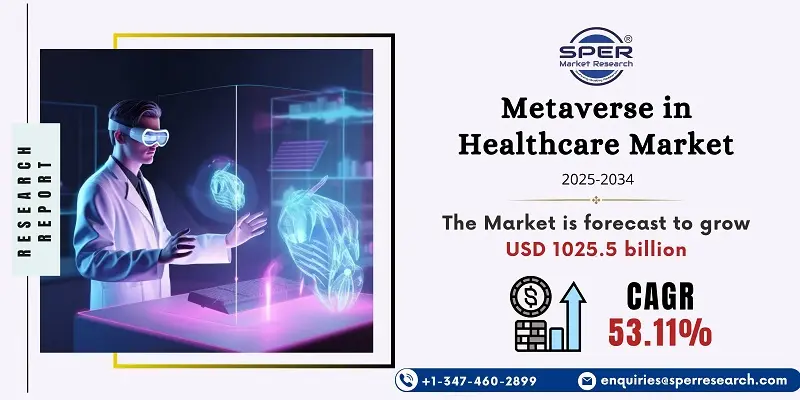
Metaverse in Healthcare Market Growth, Size, Trends, Revenue, Demand, Share, Future Outlook
Metaverse in Healthcare Market Size- By Technology, By Component, By Application, By End User- Regional Outlook, Competitive Strategies and Segment Forecast to 2034
| Published: Feb-2024 | Report ID: IACT2425 | Pages: 1 - 213 | Formats*: |
| Category : Information & Communications Technology | |||
- NVIDIA Corporation (US) and Microsoft (US) teamed in March 2023. This partnership will let NVIDIA Omniverse and Microsoft 365 applications link so that they can engage in the industrial metaverse, digitize their processes, and train advanced models for generative AI and other applications.
- GE Healthcare (US) and MediviewXR (US) partnered in November 2022. The development of the OmnifyXR medical imaging system was the goal of this partnership.


| Report Metric | Details |
| Market size available for years | 2021-2034 |
| Base year considered | 2024 |
| Forecast period | 2025-2034 |
| Segments covered | By Component, By Technology, By Application, By End Use. |
| Regions covered | North America, Asia-Pacific, Latin America, Middle East & Africa and Europe. |
| Companies Covered | Brainlab, Medtronic PLC, Meta Platforms Inc, Microsoft Corporation, Nvidia Corporation, Roblox Corporation, Sesame, Inc., Siemens Healthineers, Veyond Metaverse, and Zimmer Biomet Holdings, Inc., along with others.. |
- Global Metaverse in Healthcare Market Size (FY’2025-FY’2034)
- Overview of Global Metaverse in Healthcare Market
- Segmentation of Global Metaverse in Healthcare Market By Component (Hardware, Software, Services)
- Segmentation of Global Metaverse in Healthcare Market By Technology (AR and VR, IoT and Wearable Health Devices, Artificial Intelligence, Others)
- Segmentation of Global Metaverse in Healthcare Market By Application (Telemedicine, Medical Training and Simulation, Remote Monitoring, Robot-Assisted Surgery, Others)
- Segmentation of Global Metaverse in Healthcare Market By End Use (Clinical Research, Medical Centers, Diagnostic Centers, Medical Device Manufacturers, Biotech and Pharmaceutical Companies, Others)
- Statistical Snap of Global Metaverse in Healthcare Market
- Expansion Analysis of Global Metaverse in Healthcare Market
- Problems and Obstacles in Global Metaverse in Healthcare Market
- Competitive Landscape in the Global Metaverse in Healthcare Market
- Details on Current Investment in Global Metaverse in Healthcare Market
- Competitive Analysis of Global Metaverse in Healthcare Market
- Prominent Players in the Global Metaverse in Healthcare Market
- SWOT Analysis of Global Metaverse in Healthcare Market
- Global Metaverse in Healthcare Market Future Outlook and Projections (FY’2025-FY’2034)
- Recommendations from Analyst
1.1. Scope of the report1.2. Market segment analysis
2.1. Research data source
2.1.1. Secondary Data2.1.2. Primary Data2.1.3. SPERs internal database2.1.4. Premium insight from KOLs
2.2. Market size estimation
2.2.1. Top-down and Bottom-up approach
2.3. Data triangulation
4.1. Driver, Restraint, Opportunity and Challenges analysis
4.1.1. Drivers4.1.2. Restraints4.1.3. Opportunities4.1.4. Challenges
5.1. SWOT Analysis
5.1.1. Strengths5.1.2. Weaknesses5.1.3. Opportunities5.1.4. Threats
5.2. PESTEL Analysis
5.2.1. Political Landscape5.2.2. Economic Landscape5.2.3. Social Landscape5.2.4. Technological Landscape5.2.5. Environmental Landscape5.2.6. Legal Landscape
5.3. PORTERs Five Forces
5.3.1. Bargaining power of suppliers5.3.2. Bargaining power of buyers5.3.3. Threat of Substitute5.3.4. Threat of new entrant5.3.5. Competitive rivalry
5.4. Heat Map Analysis
6.1. Global Metaverse in Healthcare Market Manufacturing Base Distribution, Sales Area, Product Type6.2. Mergers & Acquisitions, Partnerships, Product Launch, and Collaboration in Global Metaverse in Healthcare Market
7.1. Hardware7.2. Software7.3. Services
8.1. AR and VR8.2. IoT and Wearable Health Devices8.3. Artificial Intelligence8.4. Others
9.1. Telemedicine9.2. Medical Training and Simulation9.3. Remote Monitoring9.4. Robot-Assisted Surgery9.5. Others
10.1. Clinical Research10.2. Medical Centers10.3. Diagnostic Centers10.4. Medical Device Manufacturers10.5. Biotech and Pharmaceutical Companies10.6. Others
11.1. Global Metaverse in Healthcare Market Size and Market Share
12.1. Asia-Pacific
12.1.1. Australia12.1.2. China12.1.3. India12.1.4. Japan12.1.5. South Korea12.1.6. Rest of Asia-Pacific
12.2. Europe
12.2.1. France12.2.2. Germany12.2.3. Italy12.2.4. Spain12.2.5. United Kingdom12.2.6. Rest of Europe
12.3. Middle East and Africa
12.3.1. Kingdom of Saudi Arabia12.3.2. United Arab Emirates12.3.3. Qatar12.3.4. South Africa12.3.5. Egypt12.3.6. Morocco12.3.7. Nigeria12.3.8. Rest of Middle-East and Africa
12.4. North America
12.4.1. Canada12.4.2. Mexico12.4.3. United States
12.5. Latin America
12.5.1. Argentina12.5.2. Brazil12.5.3. Rest of Latin America
13.1. Brainlab
13.1.1. Company details13.1.2. Financial outlook13.1.3. Product summary13.1.4. Recent developments
13.2. Medtronic PLC
13.2.1. Company details13.2.2. Financial outlook13.2.3. Product summary13.2.4. Recent developments
13.3. Meta Platforms Inc
13.3.1. Company details13.3.2. Financial outlook13.3.3. Product summary13.3.4. Recent developments
13.4. Microsoft Corporation
13.4.1. Company details13.4.2. Financial outlook13.4.3. Product summary13.4.4. Recent developments
13.5. Nvidia Corporation
13.5.1. Company details13.5.2. Financial outlook13.5.3. Product summary13.5.4. Recent developments
13.6. Roblox Corporation
13.6.1. Company details13.6.2. Financial outlook13.6.3. Product summary13.6.4. Recent developments
13.7. Sesame, Inc.
13.7.1. Company details13.7.2. Financial outlook13.7.3. Product summary13.7.4. Recent developments
13.8. Siemens Healthineers
13.8.1. Company details13.8.2. Financial outlook13.8.3. Product summary13.8.4. Recent developments
13.9. Veyond Metaverse
13.9.1. Company details13.9.2. Financial outlook13.9.3. Product summary13.9.4. Recent developments
13.10. Zimmer Biomet Holdings, Inc.
13.10.1. Company details13.10.2. Financial outlook13.10.3. Product summary13.10.4. Recent developments
13.11. Others
SPER Market Research’s methodology uses great emphasis on primary research to ensure that the market intelligence insights are up to date, reliable and accurate. Primary interviews are done with players involved in each phase of a supply chain to analyze the market forecasting. The secondary research method is used to help you fully understand how the future markets and the spending patterns look likes.
The report is based on in-depth qualitative and quantitative analysis of the Product Market. The quantitative analysis involves the application of various projection and sampling techniques. The qualitative analysis involves primary interviews, surveys, and vendor briefings. The data gathered as a result of these processes are validated through experts opinion. Our research methodology entails an ideal mixture of primary and secondary initiatives.



Frequently Asked Questions About This Report
PLACE AN ORDER
Year End Discount
Sample Report
Pre-Purchase Inquiry
NEED CUSTOMIZATION?
Request CustomizationCALL OR EMAIL US
100% Secure Payment






Related Reports
Our Global Clients
Our data-driven insights have influenced the strategy of 200+ reputed companies across the globe.




















